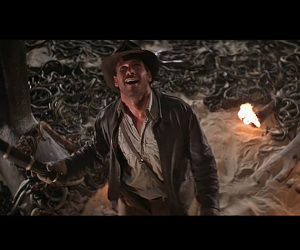
Termination: AV Goes Back to Spool
AV goes back to spool for a format lesson.
Text:/ Graeme Hague
The other day I had to do a small corporate AV gig: a folding rear-projection screen with a projector installed as per usual (on a table with a telephone book beneath and a couple of drink coasters under one leg). The client wanted to use two MacBooks so there was a vision switcher involved, however, the Macs weren’t available yet so I plugged in my own laptop just to create a signal. Once everything was connected and powered up the resulting picture – a product of the various device’s default settings – looked like something Salvador Dali would splash out on a bad hair day. The next step was to imitate one of those ancient Indian goddesses with a dozen arms as you operate several remote controls simultaneously in an attempt to make the image appear vaguely okay. As you all know, the trick is to figure out just which piece of equipment needs tweaking and whether adjusting that will only cause problems further down the signal chain – which they always do. Of course, the remotes seem to have low batteries (or something) and refuse to respond to either menu commands or verbal threats. Eventually, it occurred to me that it was all a bit of a waste of time since the MacBooks’ outputs were probably going to be quite different to my Vista-driven laptop anyway.
It was a good example of how AV production companies often find themselves trying to push a square JPEG image through a round hole (the projector lens, get it?) and thanks to the myriad video formats, file compressions and screen resolutions it’s a torturous exercise in mashing the data through a series of conversions or we have to download the latest codec or media player. Small wonder really that we can ever produce something watchable and you have to ask: ‘how the hell did we ever end up with so many conflicting variables?’. We have all these impressive-sounding organisations and committees and commissions to research and study stuff on our behalf, figuring out standards, but we still have a dog’s breakfast of formats to deal with.
It was comforting to be reminded later that same night that the problem’s been around a while. In my motel room, Foxtel was showing Lawrence of Arabia yet again. The film was shot in Super Panavision 70 and if you think that some widescreen and cinemascope displays can be annoyingly letterboxed on your telly, this was like watching the movie through the slit in Ned Kelly’s tin helmet. It doesn’t help that Omar Sharif is affecting an educated English accent, while Sir Alec Guinness is trying to look and sound like an Arab – and revealing that he’s made a very long career out of dressing like Obi-Wan Kenobi.
But I digress. I’m familiar with the problem of odd film configurations. You see, in another life I was a cinema projectionist and we regularly screened foreign ‘festival’ films that sometimes presented a real puzzle as to the precise aspect ratio of the film stock. Some European standards created a nightmare variety of weird and wonderful formats – something to do with the Napoleonic wars and driving on the wrong side of the road… probably. Under the projector was a collection of dusty, esoteric lenses to cover most eventualities and honestly it was so much fun to be scrabbling frantically around in the dark, a torch clamped in my teeth, searching for another lens when the first screening revealed unwanted anomalies like squishy-looking people or the subtitles appearing somewhere in the front rows of seats. You couldn’t help but rage at the cinema gods and demand to know why everything couldn’t simply be shot in good ol’ 2.35:1 ratio widescreen.
That isn’t the worst that can happen. Today’s digital formats can be frustrating, but be grateful that AV data has all kinds of file names and meta-tags to identify what is what. Meanwhile, 35mm film isn’t so lucky.
Watching Peter O’Toole again doing his inimitable thing in ultra-letterbox mode reminded me. There’s a kind of film projectionist’s brotherhood. We have a secret handshake and everything. This is because we rely heavily on each other. You may not know that movies on 35mm film stock come in reels of roughly 20 minutes each, so four-hour monsters like Titanic and Lawrence arrive in 12 different spools. The reels have headers and tails attached that identify their sequence in the movie – which order they are to be spliced together. Without these heads and tails it’s impossible to determine which spool is which, short of watching the film and hoping to see a clue. We all depend on each other to pay close attention to assembling the film and, more importantly, relabelling the spools correctly afterwards for the next guy.
It avoids awkward moments like we had during our own ‘classic’ screening of Lawrence of Arabia. One of the crew chatting in the projector room suddenly went still and pointed at the screen.
‘Ah, didn’t that guy get killed about 20 minutes ago?’
Yep, we had it wrong. And if one spool is out of sequence goodness knows what will happen further into the film. There’s nothing you can do about it that doesn’t require hours of rewinding and resplicing. So we let the movie run and hoped nobody noticed, the longest four hours of our lives.
Trust me, fiddling with the keystoning on data projector isn’t so bad after all.














RESPONSES